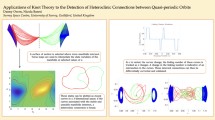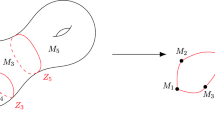Abstract
The Bicircular Problem (BCP) is a periodic time dependent perturbation of the Earth-Moon Restricted Three-Body Problem that includes the direct gravitational effect of the Sun. In this paper we use the BCP to study the existence of Halo-like orbits around \(L_2\) in the Earth-Moon system taking into account the perturbation of the Sun. By means of computing families of 2D invariant tori, we show that there are at least two different families of Halo-like quasi-periodic orbits around \(L_2\).















Similar content being viewed by others
References
Andreu, M.A.: The Quasi-Bicircular Problem. PhD thesis, Univ. Barcelona (1998)
Andreu, M.A.: Dynamics in the center manifold around \(L_2\) in the Quasi-Bicircular Problem. Celestial Mech. 84(2), 105–133 (2002). https://doi.org/10.1023/A:1019979414586
Breakwell, J., Brown, J.: The ‘Halo’ family of 3-dimensional periodic orbits in the Earth-Moon restricted 3-body problem. Celestial Mech. 20(4), 389–404 (1979)
Carr, J.: Applications of centre manifold theory. Applied mathematical sciences. Springer, New York (1981). http://opac.inria.fr/record=b1090651. Based on a series of lectures given in the Lefschetz Center for Dynamical Systems in the Division of Applied Mathematics at Brown University during the academic year 1978-79–Pref
Castellà, E.: Sobre la dinàmica prop dels punts de Lagrange del sistema Terra-Lluna. PhD thesis, Univ. Barcelona (2003)
Castellà, E., Jorba, À.: On the vertical families of two-dimensional tori near the triangular points of the bicircular problem. Celestial Mech. 76(1), 35–54 (2000). https://doi.org/10.1023/A:1008321605028
Cronin, J., Richards, P., Russell, L.: Some periodic solutions of a four-body problem. Icarus 3, 423–428 (1964)
Crusan, J., Smith, R., Craig, D., Caram, J., Guidi, J., Gates, M., et al.: Deep space gateway concept: extending human presence into cislunar space. In: IEEE Aerospace Conference, pp. 1–10 (2018). https://doi.org/10.1109/AERO.2018.8396541
Duarte, G.: On the Dynamics Around the Collinear Points in the Sun-Jupiter System. PhD thesis, Univ. Barcelona (2020)
Farrés, A., Jorba, À.: On the high order approximation of the centre manifold for ODEs. Discrete Contin. Dyn. Syst. Ser. B 14(3), 977–1000 (2010). https://doi.org/10.3934/dcdsb.2010.14.977
Gómez, G., Mondelo, J.: The dynamics around the collinear equilibrium points of the RTBP. Phys. D 157(4), 283–321 (2001)
Gómez, G., Llibre, J., Martínez, R., Simó, C.: Station keeping of libration point orbits. ESOC contract 5648/83/D/JS(SC), final report, European Space Agency, (1985). Reprinted as Dynamics and mission design near libration points. Vol. I, Fundamentals: the case of collinear libration points, volume 2 of World Scientific Monograph Series in Mathematics (2001)
Gómez, G., Llibre, J., Martínez, R., Simó, C.: Study on orbits near the triangular libration points in the perturbed Restricted Three–Body Problem. ESOC contract 6139/84/D/JS(SC), final report, European Space Agency, 1987. Reprinted as Dynamics and mission design near libration points. Vol. II, Fundamentals: the case of triangular libration points, volume 3 of World Scientific Monograph Series in Mathematics (2001)
Gómez, G., Jorba, À., Masdemont, J., Simó, C.: Study refinement of semi-analytical Halo orbit theory. ESOC contract 8625/89/D/MD(SC), final report, European Space Agency, 1991. Reprinted as Dynamics and mission design near libration points. Vol. III, Advanced methods for collinear points, volume 4 of World Scientific Monograph Series in Mathematics (2001)
Gómez, G., Jorba, À., Masdemont, J., Simó, C.: Study of Poincaré maps for orbits near Lagrangian points. ESOC contract 9711/91/D/IM(SC), final report, European Space Agency, 1993. Reprinted as Dynamics and mission design near libration points. Vol. IV, Advanced methods for triangular points, volume 5 of World Scientific Monograph Series in Mathematics (2001)
Gonzalez, J., Mireles James, J.: High-order parameterization of stable/unstable manifolds for long periodic orbits of maps. SIAM J. Appl. Dyn. Syst. 16, 09 (2016). https://doi.org/10.1137/16M1090041
Huang, S.: Very restricted four-body problem. Technical note TN D-501, Goddard Space Flight Center, NASA (1960). https://ntrs.nasa.gov/archive/nasa/casi.ntrs.nasa.gov/19890068606.pdf
Jorba, À.: A methodology for the numerical computation of normal forms, centre manifolds and first integrals of Hamiltonian systems. Exp. Math. 8(2), 155–195 (1999)
Jorba, À.: Numerical computation of the normal behaviour of invariant curves of \(n\)-dimensional maps. Nonlinearity 14(5), 943–976 (2001). https://doi.org/10.1088/0951-7715/14/5/303
Jorba, À., Masdemont, J.: Dynamics in the center manifold of the collinear points of the restricted three body problem. Physica D 132, 189–213 (1999). https://doi.org/10.1016/S0167-2789(99)00042-1
Jorba, À., Nicolás, B.: Transport and invariant manifolds near \(L_3\) in the Earth-Moon Bicircular model. Commun. Nonlinear Sci. Numer. Simul. 89, 105327 (2020). https://doi.org/10.1016/j.cnsns.2020.105327
Jorba, À., Olmedo, E.: On the computation of reducible invariant tori on a parallel computer. SIAM J. Appl. Dyn. Syst. 8(4), 1382–1404 (2009)
Jorba, À., Villanueva, J.: On the persistence of lower dimensional invariant tori under quasi-periodic perturbations. J. Nonlinear Sci. 7(5), 427–473 (1997). https://doi.org/10.1007/s003329900036
Jorba, À., Jorba-Cuscó, M., Rosales, J.J.: The vicinity of the Earth-Moon \({L}_1\) point in the Bicircular Problem. Celestial Mech. 132(2), 11 (2020). https://doi.org/10.1007/s10569-019-9940-2
Jorba-Cuscó, M., Farrés, A., Jorba, À.: Two periodic models for the Earth-Moon system. Front. Appl. Math. Stat. 4, 32 (2018). https://doi.org/10.3389/fams.2018.00032
Le Bihan, B., Masdemont, J., Gómez, G., Lizy-Destrez, S.: Invariant manifolds of a non-autonomous quasi-bicircular problem computed via the parameterization method. Nonlinearity 30, 3040–3075 (2017)
Rosales, J., Jorba, À., Jorba-Cuscó, M.: The effect of the Sun on direct transfers from Earth to translunar Halo orbits. In preparation (2020)
Scheeres, D.J.: The restricted Hill four-body problem with applications to the Earth-Moon-Sun system. Celestial Mech. 70(2), 75–98 (1998). https://doi.org/10.1023/A:1026498608950
Seydel, R.: Practical Bifurcation and Stability Analysis. Interdisciplinary Applied Mathematics, Springer. New York (2009). https://doi.org/10.1007/978-1-4419-1740-9
Sijbrand, J.: Properties of center manifolds. Trans. Am. Math. Soc. 289(2), 431–469 (1985)
Simó, C., Gómez, G., Jorba, À., Masdemont, J.: The bicircular model near the triangular libration points of the RTBP. In: Roy, A., Steves, B. (eds.) From Newton to Chaos, pp. 343–370. Plenum Press, New York (1995)
Stoer, J., Bulirsch, R.: Introduction to Numerical Analysis, volume 12 of Texts in Applied Mathematics. Springer, New York (2002). https://doi.org/10.1007/978-0-387-21738-3
Vanderbauwhede, A.: Centre manifolds, normal forms and elementary bifurcations. In: Dynamics Reported, Vol. 2, volume 2 of Dynam. Report. Ser. Dynam. Systems Appl., pp. 89–169. Wiley, Chichester (1989)
Author information
Authors and Affiliations
Corresponding author
Ethics declarations
Conflict of interest
The authors declare that they have no conflict of interest.
Additional information
Publisher's Note
Springer Nature remains neutral with regard to jurisdictional claims in published maps and institutional affiliations.
This article is part of the topical collection on Toward the Moon and Beyond.
Guest Editors: Terry Alfriend, Pini Gurfil and Ryan P. Russell.
This work has been supported by the Spanish grant PGC2018-100699-B-I00 (MCIU/AEI/FEDER, UE) and the Catalan Grant 2017 SGR 1374. The project leading to this application has received funding from the European Union’s Horizon 2020 research and innovation programme under the Marie Skłodowska-Curie Grant Agreement #734557. The authors thank the comments by the reviwers that helped to improve this manuscript.
Appendix
Appendix
In this section we provide additional information concerning the paper. In Table 3 we provide the initial conditions (identified by the energy) of the Halo family of the RTBP that have been used to produce Fig. 5.
We also provide some examples of tori from the other families found are given (see Fig. 5). They are provided here to illustrate the richness of the Sun-Earth-Moon BCP, and to evidence that the vertical families V1 and V2 are not Halo-like. A complete study of their stability properties and how they transition from the RTBP to the BCP is under work, and no details are provided here.
The planar tori from the families H1 and H2 are very similar, and two examples of each one are shown in Fig. 16. The representative of the family H1 (left) has rotation number \(\rho = {0.522687812628674}\). The rotation number of the representative of the family H2 (right) is \(\rho = {0.258684108104417}\).
Projections of a H1 orbit (left) and a H2 orbit (right). (Identified with an empty triangle and a full pentagon respectively in Fig. 6c)
More interesting are the families V1 and V2 with a vertical component. Different projections of a representative of the family V1 with rotation number \(\rho = {0.651014628070470}\) are shown in Fig. 17. The projection onto the plane \({x=0}\) (bottom-left image) shows that this orbit falls behind the Moon.
Different projections of a V1 orbit. (Identified with a full circle in Fig. 6d)
Finally, and example of the family V2 is illustrated in Fig. 18. This torus has rotation number \(\rho = {0.585297052915989}\). It also falls behind the Moon. However, the projection onto the plane \({x=0}\) (bottom-left image) show that has different symmetry than the representative of the V1 family.
Different projections of a V2 orbit. (Identified with a full square in Fig. 6d)
Rights and permissions
About this article
Cite this article
Rosales, J.J., Jorba, À. & Jorba-Cuscó, M. Families of Halo-like invariant tori around \(L_2\) in the Earth-Moon Bicircular Problem. Celest Mech Dyn Astr 133, 16 (2021). https://doi.org/10.1007/s10569-021-10012-0
Received:
Revised:
Accepted:
Published:
DOI: https://doi.org/10.1007/s10569-021-10012-0







